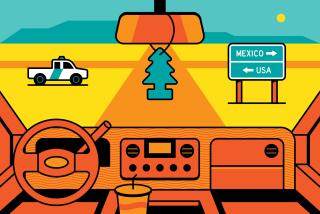Dear Street Smart:I agree that freeway exits...
- Share via
Dear Street Smart:
I agree that freeway exits in California should be numbered, but no money should be spent to number exits until the United States joins the rest of the civilized world and converts our highways to the metric system.
At present, I believe, exits on Interstate 19 between Tucson, Ariz., and Nogales, Tex., are numbered by kilometers from the Mexican border northward, which has presented no difficulties to the motoring public.
Hal Bass, Northridge
Dear Reader:
You’re absolutely correct: The exit warning signs and distance markers along Interstate 19 between Tucson and Nogales use kilometers rather than miles.
According to Bob Christ of the Arizona Department of Transportation, it’s been that way for more than 20 years, ever since they changed the name of the roadway from Highway 89 to Interstate 19.
“There’s a lot of tourism and traffic that comes up from Mexico, where they use the metric system,” Christ explains. “It’s an international highway”--not too different from Interstate 5 here in California.
The change from miles to kilometers along Interstate 19 initially sparked some complaints. “There were a lot of folks confused,” Christ said.
Most motorists have since adjusted. But die-hard opponents of the metric system can take solace in the fact that you can still find mileposts to the far right of the highway, though the kilometer markers are now more prominent.
*
Dear Street Smart:
I have come across many intersections that have left-turn arrows, and once they go red, no left turns can be made, even if no cars are coming from the other direction.
Why can’t the green left-turn arrow turn into a solid green so cars will be able to make the left turn when there are no cars coming? It doesn’t seem to be any more dangerous than at a normal intersection, and at night, when fewer cars are on the road, it is frustrating to have to wait for a green left-turn signal when it is perfectly safe to make the turn.
Kathy Schryver, Winnetka
Dear Reader:
You make a good point, but there is a reason, if not a rhyme, as to why all left-turn signals don’t give you a second chance to make the turn.
First of all, the concept of letting a left-turn signal melt into a solid green is a relatively new one. “That’s something that’s come on within the last 10 years,” said city traffic engineer Brian Gallagher.
It’s called a “protective-permissive” signal, because the turn goes from being a protected one with a left arrow to an unprotected, but permissible, turn with a solid green.
Whenever the city puts in left-turn signals nowadays, engineers try to install the protective-permissive variety. But that kind of stoplight is not suitable for all intersections.
You’ll never find such a signal at intersections with two left-turn lanes, for instance. If left turns were allowed for cars in two lanes on a solid green, one car could easily block the visibility of the other driver after both have edged out into the intersection.
Poor visibility because of topography (such as a hill or bend in the road), high speed of oncoming traffic or a high accident rate at a particular intersection will also prompt engineers to rule out unprotected left turns and regulate them with an arrow only.
And you’ll rarely find protective-permissive signals for left turns onto freeway on-ramps. Those stoplights are regulated by Caltrans, which adheres to different standards from the city, Gallagher said.
More to Read
Sign up for Essential California
The most important California stories and recommendations in your inbox every morning.
You may occasionally receive promotional content from the Los Angeles Times.













